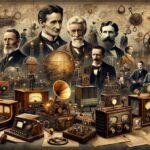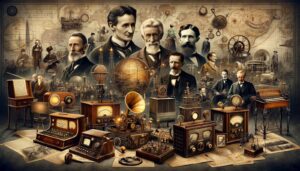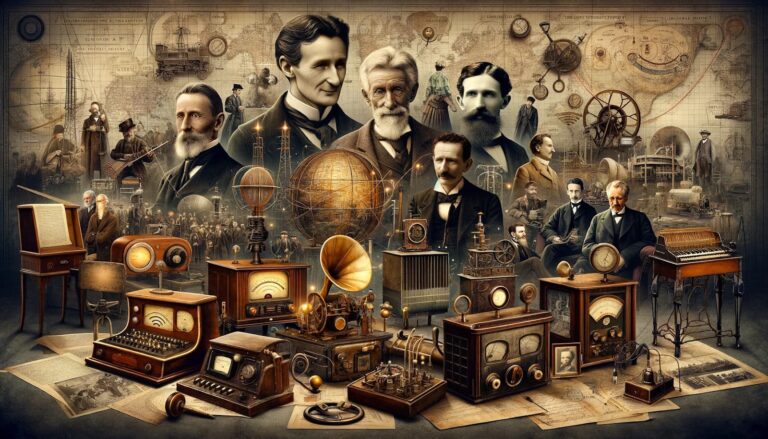Thomas Alva Edison, a name synonymous with innovation and invention, stands as one of the most renowned inventors in history. His contributions to modern life are immeasurable, encompassing groundbreaking inventions such as the incandescent light bulb, the phonograph, and the motion picture camera. With a remarkable 1,093 patents to his name, Edison’s impact on technology and society is undeniable. However, his legacy extends beyond mere invention; he was also a skilled businessman, successfully marketing his creations to the public. Additionally, for those interested in exploring the world of innovation and discovery, Book of Ra offers an exciting online platform where you can immerse yourself in the mysteries of ancient Egypt while enjoying thrilling slot game adventures.
Early Life and Background
Thomas Alva Edison was born on February 11, 1847, in Milan, Ohio, to Sam and Nancy Edison. Growing up as the youngest of seven children, Edison faced health challenges during his youth. Despite his poor health and hearing impairment, his mother’s unwavering belief in him became his driving force. Edison’s fascination with mechanical devices and chemistry emerged early in his life, foreshadowing his future endeavors.
Telegraph Work and Early Inventions
In 1859, at the age of twelve, Edison took a job as a newspaper and candy seller on the Grand Trunk Railroad to Detroit. On the train’s baggage car, he set up a makeshift laboratory for his chemistry experiments and even published the Grand Trunk Herald, the first-ever train-published newspaper. It was during this time that he lost much of his hearing, possibly due to scarlet fever or an altercation with a conductor.
In 1862, Edison performed a heroic act, saving a child from a potential train accident. As a reward, he learned railroad telegraphy from J.U. MacKenzie, the child’s grateful father. This marked the beginning of Edison’s career in telegraphy, which led him to various telegraph jobs across the United States.
In January 1869, Edison left his telegraph job to pursue full-time invention. His first patented invention, the electric vote recorder, was granted in June 1869. Edison soon learned the importance of creating inventions with market demand, leading him to develop practical devices. His move to New York City in 1869 marked the start of his remarkable journey.
Pioneering Work in Electricity
Edison’s life in New York City was characterized by a flurry of activities and numerous partnerships focused on telegraphy and electrical devices. In October 1869, he co-founded Pope, Edison, and Co., an organization specializing in electrical engineering and devices. Edison’s contributions to telegraphy innovations, including stock printers and automatic telegraphs, showcased his relentless pursuit of advancement.
Edison’s personal life underwent significant changes during this period. In 1871, his mother passed away, and later that year, he married Mary Stilwell. Their marriage was marked by challenges due to Edison’s intense work commitments and her frequent illnesses. Despite the hardships, they welcomed their children, Marion, Thomas Jr. (affectionately known as “Dot”), and William Leslie (“Dash”).
In 1876, Edison established a groundbreaking laboratory in Menlo Park, New Jersey, often referred to as an “invention factory.” Here, Edison conducted extensive experiments, tirelessly searching for solutions to various problems. His famous quote, “I never quit until I get what I’m after. Negative results are just what I’m after. They are just as valuable to me as positive results,” exemplified his relentless pursuit of innovation.
The Phonograph and Electric Light
Edison’s work with the telephone and telegraph led to the creation of the phonograph in 1877. By recording sound as indentations on a rapidly-moving piece of paper, he achieved a remarkable feat. The Edison Speaking Phonograph Company was founded in early 1878 to market this revolutionary device.
While the phonograph gained initial attention, Edison shifted his focus to electric lighting systems. In 1878, he dedicated his efforts to perfecting the incandescent light bulb, setting aside the phonograph for nearly a decade. His relentless experimentation eventually led to the development of a long-lasting light bulb using a filament of carbonized thread.
In 1881, Edison established an electric light factory in East Newark, further advancing his quest for practical electric lighting. In 1882, the first commercial electric light system was installed on Pearl Street in Lower Manhattan, marking a significant milestone in the widespread adoption of electric lighting.
Legacy and Impact
Edison’s contributions extended beyond the United States, with his lighting system gaining international recognition through exhibitions in Paris, London, and Moscow. However, his pursuit of electrical innovation was not without challenges, as the rivalry between direct current (DC) and alternating current (AC) systems, led by Edison and George Westinghouse respectively, culminated in the dominance of AC current.
The Edison General Electric Co. merged with Thomson-Houston in 1892 to become General Electric Co., distancing Edison from the electrical field of business. Despite these challenges, Edison’s legacy remains unparalleled, with his inventions fundamentally transforming the world.
In conclusion, Thomas Alva Edison’s life was marked by an insatiable curiosity, relentless innovation, and enduring impact. His inventions not only illuminated the world but also paved the way for future generations of inventors and engineers. Edison’s legacy stands as a testament to the power of determination and the pursuit of knowledge, forever illuminating the path of progress.














